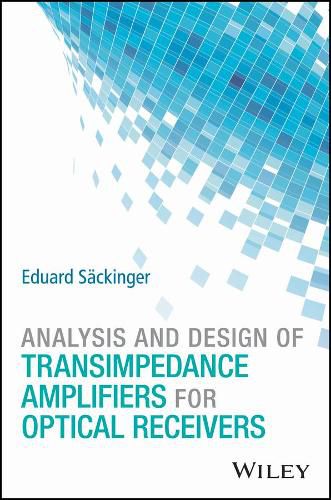Readings Newsletter
Become a Readings Member to make your shopping experience even easier.
Sign in or sign up for free!
You’re not far away from qualifying for FREE standard shipping within Australia
You’ve qualified for FREE standard shipping within Australia
The cart is loading…






An up-to-date, comprehensive guide for advanced electrical engineering studentsand electrical engineers working in the IC and optical industries
This book covers the major transimpedance amplifier (TIA) topologies and their circuit implementations for optical receivers. This includes the shunt-feedback TIA, common-base TIA, common-gate TIA, regulated-cascode TIA, distributed-amplifier TIA, nonresistive feedback TIA, current-mode TIA, burst-mode TIA, and analog-receiver TIA. The noise, transimpedance, and other performance parameters of these circuits are analyzed and optimized. Topics of interest include post amplifiers, differential vs. single-ended TIAs, DC input current control, and adaptive transimpedance. The book features real-world examples of TIA circuits for a variety of receivers (direct detection, coherent, burst-mode, etc.) implemented in a broad array of technologies (HBT, BiCMOS, CMOS, etc.).
The book begins with an introduction to optical communication systems, signals, and standards. It then moves on to discussions of optical fiber and photodetectors. This discussion includes p-i-n photodetectors; avalanche photodetectors (APD); optically preamplified detectors; integrated detectors, including detectors for silicon photonics; and detectors for phase-modulated signals, including coherent detectors. This is followed by coverage of the optical receiver at the system level: the relationship between noise, sensitivity, optical signal-to-noise ratio (OSNR), and bit-error rate (BER) is explained; receiver impairments, such as intersymbol interference (ISI), are covered. In addition, the author presents TIA specifications and illustrates them with example values from recent product data sheets. The book also includes:
Many numerical examples throughout that help make the material more concrete for readers Real-world product examples that show the performance of actual IC designs Chapter summaries that highlight the key points Problems and their solutions for readers who want to practice and deepen their understanding of the material Appendices that cover communication signals, eye diagrams, timing jitter, nonlinearity, adaptive equalizers, decision point control, forward error correction (FEC), and second-order low-pass transfer functions
Analysis and Design of Transimpedance Amplifiers for Optical Receivers belongs on the reference shelves of every electrical engineer working in the IC and optical industries. It also can serve as a textbook for upper-level undergraduates and graduate students studying integrated circuit design and optical communication.
$9.00 standard shipping within Australia
FREE standard shipping within Australia for orders over $100.00
Express & International shipping calculated at checkout
An up-to-date, comprehensive guide for advanced electrical engineering studentsand electrical engineers working in the IC and optical industries
This book covers the major transimpedance amplifier (TIA) topologies and their circuit implementations for optical receivers. This includes the shunt-feedback TIA, common-base TIA, common-gate TIA, regulated-cascode TIA, distributed-amplifier TIA, nonresistive feedback TIA, current-mode TIA, burst-mode TIA, and analog-receiver TIA. The noise, transimpedance, and other performance parameters of these circuits are analyzed and optimized. Topics of interest include post amplifiers, differential vs. single-ended TIAs, DC input current control, and adaptive transimpedance. The book features real-world examples of TIA circuits for a variety of receivers (direct detection, coherent, burst-mode, etc.) implemented in a broad array of technologies (HBT, BiCMOS, CMOS, etc.).
The book begins with an introduction to optical communication systems, signals, and standards. It then moves on to discussions of optical fiber and photodetectors. This discussion includes p-i-n photodetectors; avalanche photodetectors (APD); optically preamplified detectors; integrated detectors, including detectors for silicon photonics; and detectors for phase-modulated signals, including coherent detectors. This is followed by coverage of the optical receiver at the system level: the relationship between noise, sensitivity, optical signal-to-noise ratio (OSNR), and bit-error rate (BER) is explained; receiver impairments, such as intersymbol interference (ISI), are covered. In addition, the author presents TIA specifications and illustrates them with example values from recent product data sheets. The book also includes:
Many numerical examples throughout that help make the material more concrete for readers Real-world product examples that show the performance of actual IC designs Chapter summaries that highlight the key points Problems and their solutions for readers who want to practice and deepen their understanding of the material Appendices that cover communication signals, eye diagrams, timing jitter, nonlinearity, adaptive equalizers, decision point control, forward error correction (FEC), and second-order low-pass transfer functions
Analysis and Design of Transimpedance Amplifiers for Optical Receivers belongs on the reference shelves of every electrical engineer working in the IC and optical industries. It also can serve as a textbook for upper-level undergraduates and graduate students studying integrated circuit design and optical communication.